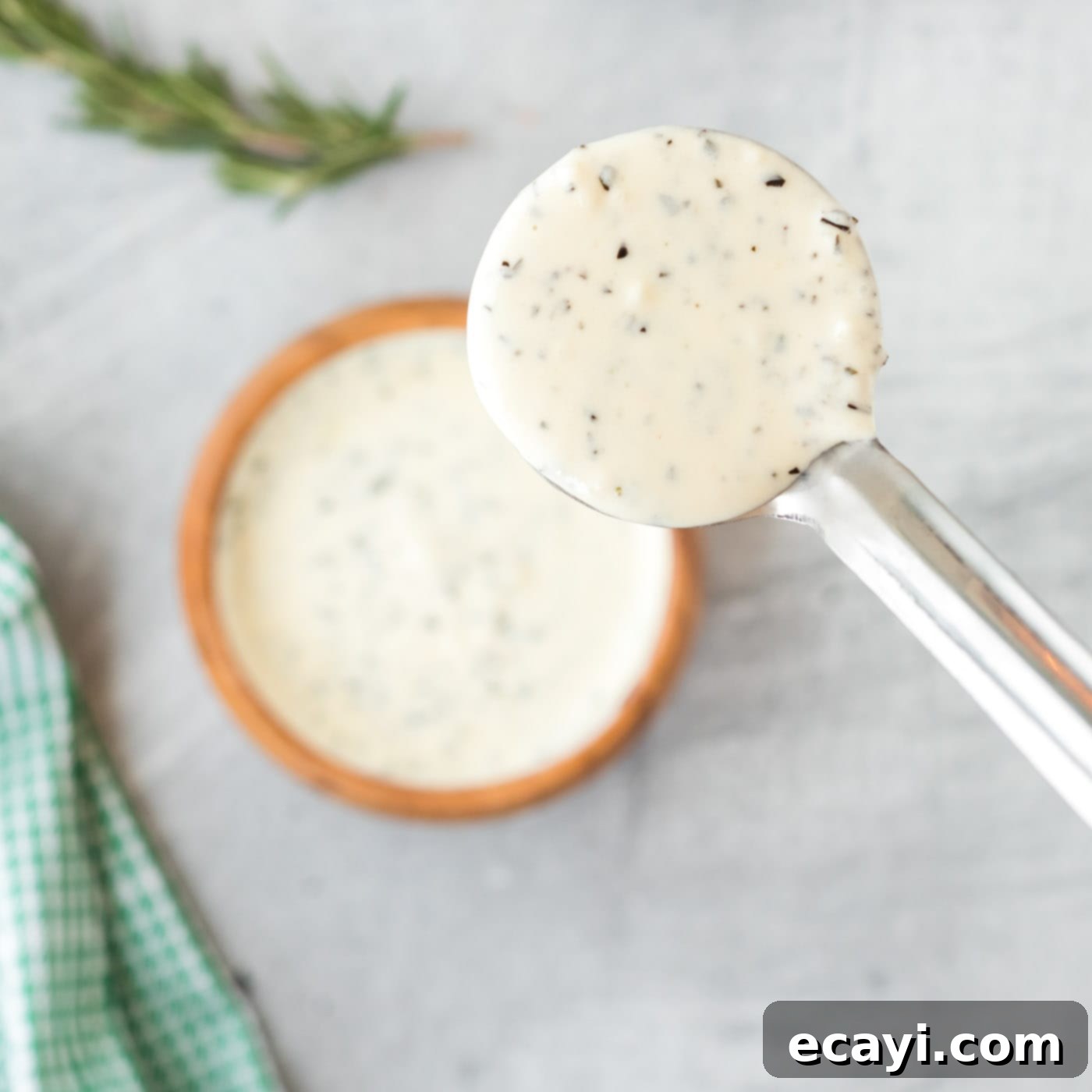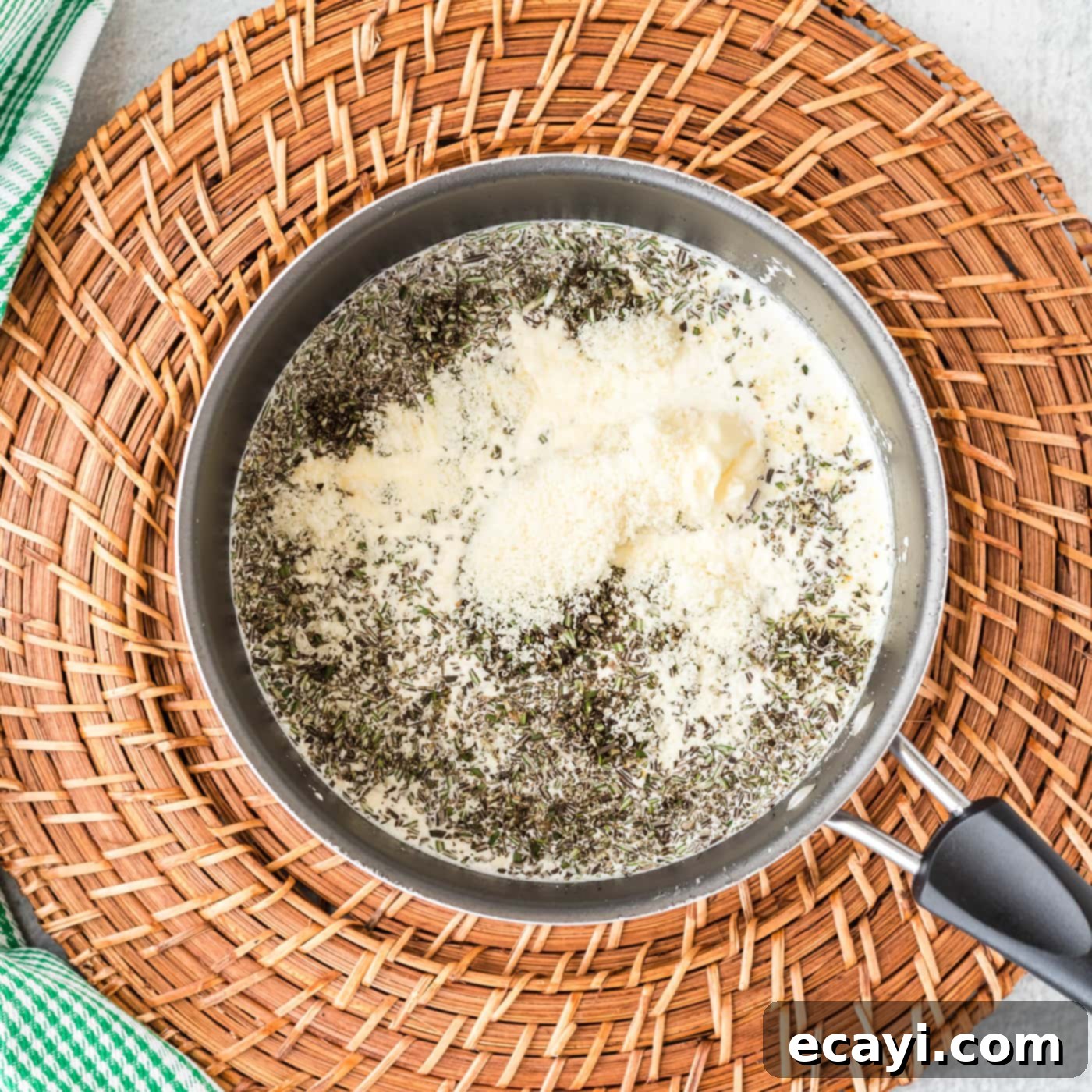Quick & Easy Homemade Rosemary Cream Sauce: Your Go-To Recipe for Flavorful Meals
Discover the secret to elevating your everyday meals with this incredibly rich, smooth, and aromatic rosemary cream sauce. Crafted in a single pot and ready in just 15 minutes, this herb-infused delight is perfect for drizzling over succulent chicken, delicate fish, crisp fresh vegetables, or even tossed with your favorite pasta. It’s an effortless way to introduce a touch of creamy decadence and sophisticated flavor to your dinner table, transforming simple ingredients into a gourmet experience.
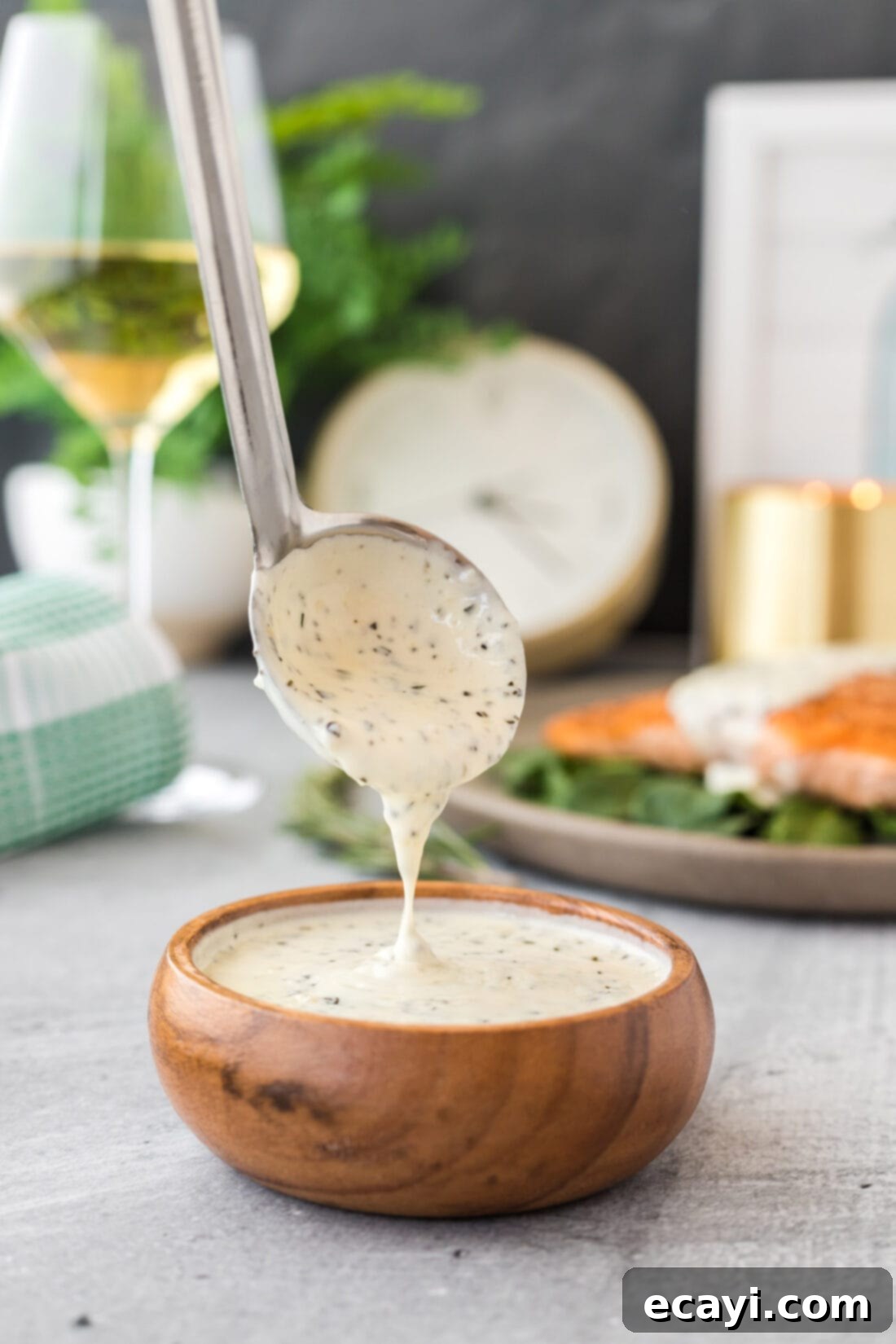
Why This Speedy Rosemary Cream Sauce Recipe Will Become Your Favorite
While you might typically associate rosemary with its dried form, ideal for seasoning roasted potatoes, enhancing marinades, or creating robust seasoning rubs, this rosemary cream sauce truly shines as an exceptional method to utilize an abundance of fresh rosemary from your garden. There’s a profound difference in the vibrant, piney aroma and subtle floral notes that fresh rosemary imparts, which dried versions simply can’t replicate.
This recipe is a game-changer because of its unparalleled versatility and astonishing speed. In merely 15 minutes, with just 7 common ingredients, you can whip up a sauce that complements an impressive array of dishes. Imagine it beautifully coating meats such as tender roasted chicken, pan-seared salmon, or perfectly cooked beef. It’s equally divine with an assortment of fresh or roasted vegetables, adding a creamy dimension, and it transforms simple pasta into a restaurant-quality meal. The ease of preparation ensures that even on the busiest weeknights, a truly special and flavorful dinner is well within reach, making it an indispensable addition to your culinary repertoire.
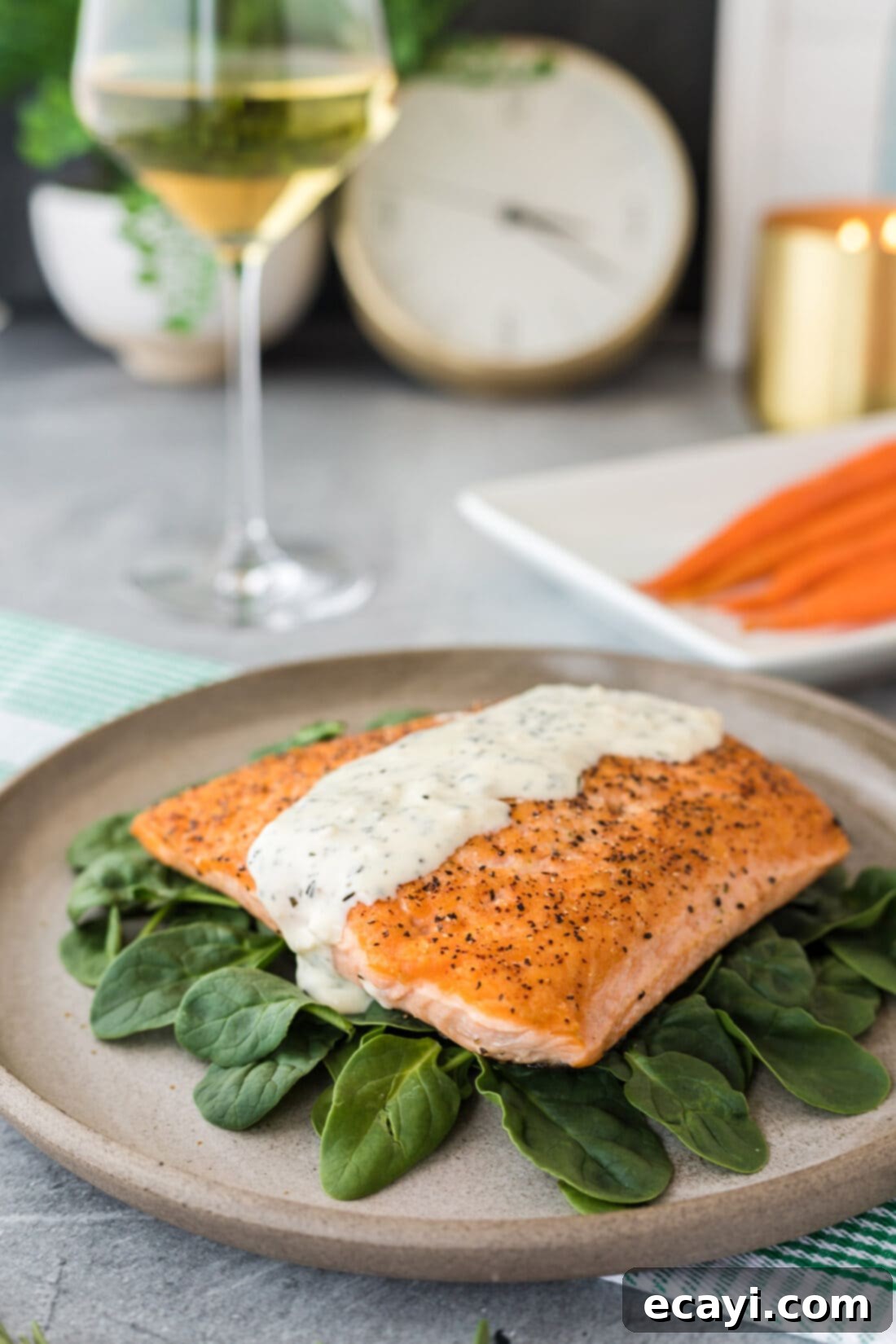
Essential Ingredients You Will Need for This Recipe
Creating this exquisite rosemary cream sauce requires a handful of accessible ingredients that come together to form a truly harmonious flavor profile. Before you begin, gather the following:
- Butter
- Minced Garlic
- Minced Fresh Rosemary
- Heavy Whipping Cream
- Grated Parmesan Cheese
- Garlic Salt
- Cornstarch
For precise measurements and detailed instructions, scroll to the printable recipe card located at the end of this post. This overview ensures you have all the necessary components ready to achieve a perfect, velvety sauce every time.
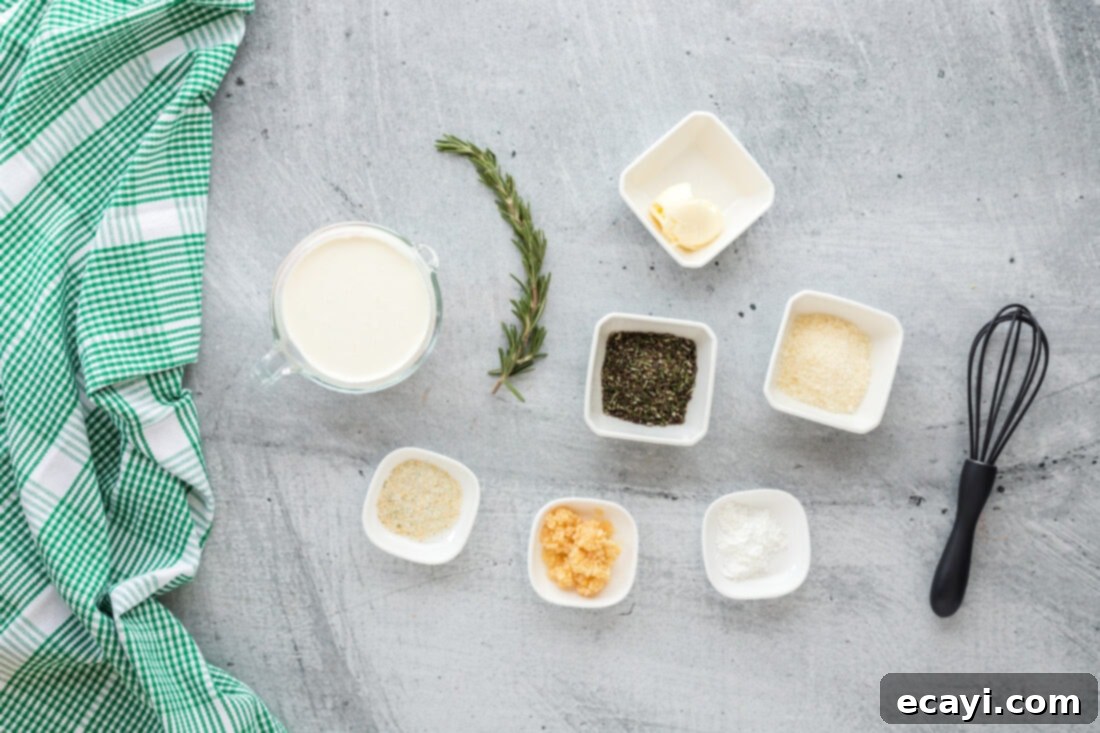
Ingredient Insights and Smart Substitution Suggestions
Understanding your ingredients is key to successful cooking. Here’s a deeper look into the components of our rosemary cream sauce and how to make the best choices or smart substitutions.
CORNSTARCH: The Secret to Quick Thickness
Cornstarch is our preferred thickening agent in this recipe, allowing the sauce to achieve its desired consistency rapidly without extensive simmering. When mixed with a small amount of cold liquid (often water or a splash of cream), it forms a slurry that, when whisked into the hot sauce, prevents lumps and ensures a smooth finish. While you could technically reduce the cream over a longer period to thicken it, using cornstarch helps maintain volume and speeds up the process significantly. If you don’t have cornstarch, a small amount of all-purpose flour could be used, first whisked into melted butter to form a roux, then proceeding with the recipe. Alternatively, arrowroot powder is another excellent gluten-free thickener that can be used similarly to cornstarch.
CHEESE: The Parmesan Difference
For the most authentic flavor and optimal melt, I highly recommend grating your Parmesan cheese fresh from the block. Pre-grated Parmesan often contains cellulose, an anti-caking agent designed to prevent clumping. While harmless, this additive can slightly hinder the cheese’s ability to melt smoothly into your sauce, sometimes resulting in a grainier texture. Freshly grated Parmesan offers a superior creamy texture and a richer, more nuanced flavor profile. However, if convenience is paramount, finely grated Parmesan from the store will still yield a delicious result in a pinch. Consider trying Pecorino Romano for a sharper, saltier kick, or Grana Padano for a slightly milder, nuttier flavor if you want to experiment with other hard Italian cheeses.
ROSEMARY: Freshness is Key
As highlighted, fresh rosemary is a star in this recipe. Its bright, woody, and slightly citrusy notes are truly distinctive. When mincing fresh rosemary, ensure you remove the leaves from the woody stems first, as the stems are too tough to eat. Finely mincing the leaves allows their essential oils to release effectively into the sauce. While fresh is always best here, if you must use dried rosemary, use about half the amount specified for fresh, as dried herbs are more concentrated in flavor. Crush it lightly between your fingers before adding to help release its aromatics. Other complementary fresh herbs like thyme or a hint of sage can also be added alongside the rosemary for an even deeper herbaceous profile.
HEAVY WHIPPING CREAM: The Foundation of Richness
Heavy whipping cream provides the luxurious, velvety base for this sauce. Its high fat content (typically 36% or more) is what gives the sauce its richness and helps prevent it from curdling. For a slightly lighter sauce, you could use half-and-half, but be aware that it will result in a thinner consistency and less decadent mouthfeel. If using half-and-half or whole milk, you might need to increase the cornstarch slightly or simmer the sauce a little longer to achieve the desired thickness. Avoid using low-fat milk, as it’s more prone to separating or curdling under heat and won’t give you the desired creamy texture.
GARLIC: Flavor Booster
Freshly minced garlic is always recommended for the most potent and aromatic flavor. Two tablespoons might seem like a lot, but it mellows beautifully in the sauce and provides a wonderful depth. If you’re short on time, pre-minced garlic from a jar can work, but reduce the quantity slightly as its flavor can sometimes be stronger. For a milder garlic note, consider using garlic powder, but fresh cloves will always deliver the best taste. Garlic salt, as used in the recipe, adds both garlic flavor and seasoning; if using plain salt and fresh garlic, adjust the salt content to your taste.
BUTTER: Richness and Sautéing
Butter serves multiple purposes: it helps sauté the aromatics and adds to the overall richness and mouthfeel of the sauce. Unsalted butter gives you more control over the final salt content, which is useful given that Parmesan cheese and garlic salt are also contributors. If using salted butter, you might want to slightly reduce the amount of garlic salt initially and taste before adding more.
How to Make This Irresistibly Creamy Rosemary Sauce
These step-by-step photos and detailed instructions are provided to help you visualize the process of making this delightful sauce. For the complete, printable version of this recipe, including exact measurements and a comprehensive list of instructions, simply Jump to Recipe at the bottom of this page.
- Sauté Aromatics: Begin by melting the butter in a saucepan over medium heat. Once the butter is melted and shimmering, add the minced garlic and fresh minced rosemary. Sauté gently for 1-2 minutes. The goal is to make them fragrant, not to brown them, which could impart a bitter taste to the sauce. You’ll know they’re ready when a wonderful aroma fills your kitchen.
- Add Cream and Simmer: Pour in the heavy cream. Bring the mixture to a gentle boil over medium heat, making sure to whisk constantly. Continuous whisking is crucial here to prevent the cream from scorching at the bottom of the pan and to ensure a smooth, even texture as it heats up. Keep a close eye on it; you want a gentle simmer, not a vigorous boil.
- Incorporate Cheese and Seasoning: Once the cream is gently simmering, whisk in the grated Parmesan cheese and garlic salt. Continue whisking until the cheese is fully melted and incorporated into the sauce, creating a uniform, creamy consistency. This step infuses the sauce with savory depth.

Whisking the ingredients in the saucepan to create a smooth, homogenous sauce. - Thicken to Perfection: Reduce the heat to low. Add the cornstarch, ensuring it’s evenly distributed, and whisk continuously over low heat until the sauce visibly thickens to your desired consistency. This should happen relatively quickly, usually within a minute or two. The cornstarch works wonders for quick thickening while maintaining the sauce’s volume and luxurious feel. Once thickened, remove from heat and serve immediately.
Frequently Asked Questions & Expert Tips for Rosemary Cream Sauce
Here are some common questions and expert advice to help you master this delicious rosemary cream sauce:
Store any leftover rosemary cream sauce in an airtight jar or container in the refrigerator for up to 3-4 days. When you’re ready to enjoy it again, reheat the sauce gently in a saucepan over medium-low heat, stirring frequently. This slow reheating method prevents the sauce from separating or scorching. If it appears too thick after refrigeration, add a small splash of heavy cream, milk, or even water while reheating to bring it back to its original silky consistency.
Absolutely, making this sauce ahead of time is a fantastic way to streamline your meal prep. You can easily prepare the rosemary cream sauce a day in advance, which will save you precious time in the kitchen when you’re ready to serve. Store it in a container with a sealed lid in the refrigerator. When reheating, follow the steps above: use medium-low heat and stir often. As mentioned, a splash of heavy cream or water can help loosen it up if it has become too thick overnight.
Yes, you can freeze this sauce, but with a small caveat. Cream-based sauces sometimes have a tendency to “split” or separate when frozen and then thawed, due to the fat content. However, it should still reheat nicely if you handle it correctly. To minimize splitting, ensure you thaw the sauce in the refrigerator overnight. Then, reheat it slowly in a saucepan over low heat, whisking constantly to re-emulsify any separated liquids. If freezing, always leave adequate space at the top of the jar or container (about an inch) for the sauce to expand as it freezes.
If your sauce is too thick, simply whisk in a tablespoon or two of warm heavy cream, milk, or even a bit of vegetable or chicken broth until it reaches your desired consistency. If it’s too thin, you have a couple of options: you can simmer it gently for a few more minutes to allow it to reduce and thicken naturally, or you can create a very small cornstarch slurry (1/2 teaspoon cornstarch mixed with 1 tablespoon cold water) and whisk it into the simmering sauce, cooking for another minute until thickened. Always add thickeners gradually to avoid an overly thick result.
Adapting this recipe for dairy-free or vegan diets is possible, though the flavor and texture will naturally differ. Substitute the butter with a good quality vegan butter. For the heavy cream, use a full-fat canned coconut milk (the thick cream at the top of the can) or a high-quality vegan cream substitute like cashew cream or oat-based cream. Replace Parmesan cheese with a nutritional yeast blend (which offers a cheesy flavor) or a vegan Parmesan alternative. Be mindful that vegan creams may not thicken exactly like dairy cream, so adjust cornstarch as needed.
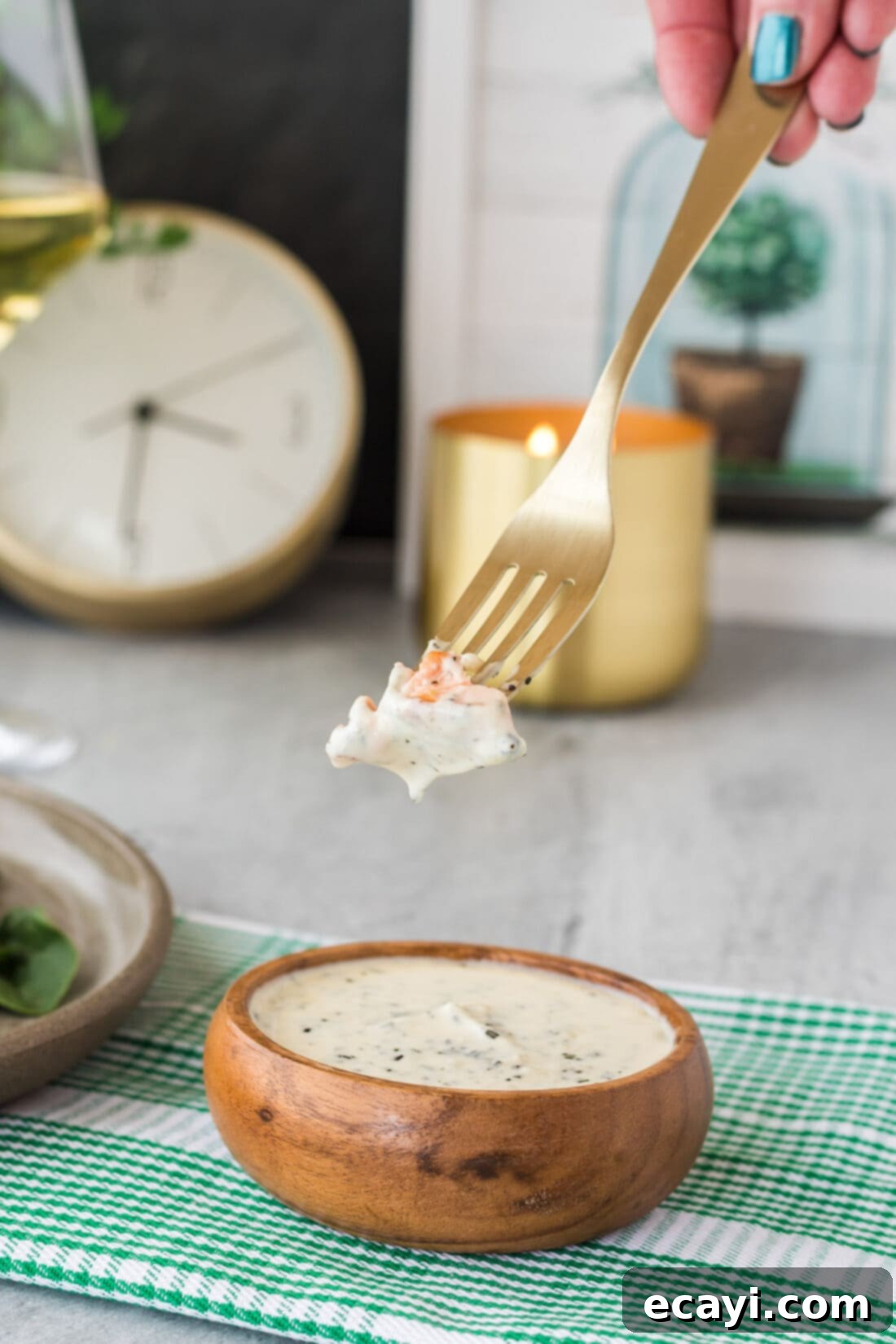
Delicious Serving Suggestions to Inspire You
The beauty of this rosemary cream sauce lies in its incredible versatility. It can effortlessly enhance a wide range of dishes, transforming simple meals into something truly special. Here are some of our favorite ways to enjoy it:
- With Pasta: Toss it with freshly cooked fettuccine, linguine, penne, or tortellini for a quick and satisfying meal. Add some sautéed mushrooms or spinach for extra depth.
- Over Seafood: It’s an exceptional pairing for fish like pan-seared salmon, baked cod, or grilled shrimp. The creamy, herbaceous notes beautifully complement the delicate flavors of seafood.
- Poultry Perfection: Drizzle generously over roasted chicken breast, grilled chicken thighs, or even a whole roasted chicken. It adds moisture and a burst of flavor.
- Meaty Mains: Don’t limit yourself to poultry or fish! This sauce is surprisingly good with other meats, such as seared steak, pork chops, or even lamb.
- Vegetable Enhancement: Transform everyday vegetables into a gourmet side dish. Pour over steamed asparagus, roasted broccoli, green beans, or sautéed zucchini. It’s also fantastic with creamy mashed potatoes, polenta, or baked potatoes.
- Breakfast & Brunch: Get creative and serve it alongside scrambled eggs, omelets, or even as a unique Hollandaise alternative over eggs Benedict.
- Sandwiches & Wraps: Use it as a gourmet spread in sandwiches or wraps for an unexpected burst of flavor.
No matter how you choose to serve it, this rosemary cream sauce is guaranteed to impress with its rich flavor and smooth texture. Enjoy creating your next culinary masterpiece!
Explore More Homemade Sauce Recipes
If you love the idea of creating your own delicious sauces from scratch, you’re in for a treat! Homemade sauces not only taste better but often allow you to control the ingredients, ensuring freshness and quality. Here are some other fantastic homemade sauce recipes to broaden your culinary horizons:
- Classic Homemade Pizza Sauce
- Decadent Homemade Caramel Sauce
- Rich Bolognese Sauce
- Tangy Alabama White Sauce
- Authentic Homemade Enchilada Sauce
- Creamy Vodka Sauce
Each of these recipes offers a unique flavor profile and can transform various dishes, just like our versatile rosemary cream sauce.
I’m passionate about baking and cooking, and I love sharing my kitchen adventures and recipes with all of you! It can be hard to remember to check back every day, which is why I offer a convenient newsletter delivered directly to your inbox every time a new recipe is posted. Simply subscribe here and start receiving your free daily recipes to inspire your next meal!
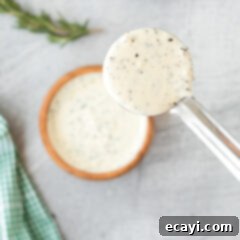
Rosemary Cream Sauce
IMPORTANT – There are often Frequently Asked Questions within the blog post that you may find helpful. Simply scroll back up to read them!
Print It
Pin It
Rate It
Save ItSaved!
Ingredients
- 1 Tablespoon butter
- 2 Tablespoons minced garlic
- 1 ½ Tablespoons minced fresh rosemary
- 1 cup heavy whipping cream
- 1 ½ Tablespoons grated parmesan cheese
- ½ teaspoon garlic salt
- 1 teaspoon cornstarch
Things You’ll Need
-
Saucepan
-
Whisk
Before You Begin
- This sauce is excellent over fish and/or fresh vegetables. Can also be served over other meats like chicken and steak.
- Store leftovers in an air-tight container or mason jar in the refrigerator for 3-4 days.
- While using cornstarch is not a necessary step as you can simply continue to simmer the sauce until the cream cooks down and thickens, you will lose volume. Using cornstarch thickens it quickly and allows you to keep the volume.
Instructions
-
Melt butter in a saucepan over medium heat. Add garlic and rosemary and saute for 1-2 minutes or until fragrant.
-
Add heavy cream and bring to a gentle boil over medium heat, whisking constantly.
-
Whisk in parmesan cheese and garlic salt.
-
Reduce heat to low. Add cornstarch and whisk over low heat until thickened.
Nutrition
The recipes on this blog are tested with a conventional gas oven and gas stovetop. It’s important to note that some ovens, especially as they age, can cook and bake inconsistently. Using an inexpensive oven thermometer can assure you that your oven is truly heating to the proper temperature. If you use a toaster oven or countertop oven, please keep in mind that they may not distribute heat the same as a conventional full sized oven and you may need to adjust your cooking/baking times. In the case of recipes made with a pressure cooker, air fryer, slow cooker, or other appliance, a link to the appliances we use is listed within each respective recipe. For baking recipes where measurements are given by weight, please note that results may not be the same if cups are used instead, and we can’t guarantee success with that method.
